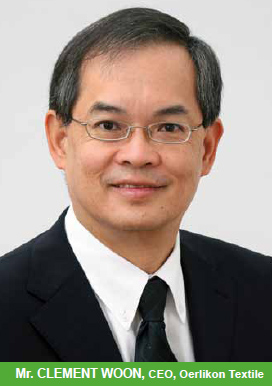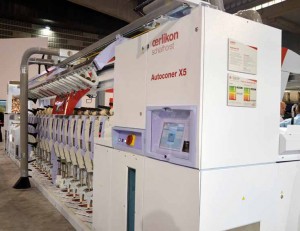China & India, key growth markets
 Oerlikon Textile reported improved profitability in 2011, producing a record EBIT margin of 9 per cent. All business units (BUs) generated strong sales growth and made a positive contribution to the Segment’s profitability. The Segment’s EBIT of CHF 183 million clearly reflects the positive impact of the operating improvements made in all of its business locations (EBIT 2010: CHF 21 million).
Oerlikon Textile reported improved profitability in 2011, producing a record EBIT margin of 9 per cent. All business units (BUs) generated strong sales growth and made a positive contribution to the Segment’s profitability. The Segment’s EBIT of CHF 183 million clearly reflects the positive impact of the operating improvements made in all of its business locations (EBIT 2010: CHF 21 million).
Sales at Oerlikon Textile rose by 23 per cent from CHF 1 653 million to CHF 2 037 million. As expected, order intake decreased to CHF 1 977 million after hitting a high of CHF 2 509 million in 2010. This decrease was due to weaker demand for natural fibers in the second half of the year, a development fuelled in part by higher prices for cotton. As the year progressed, this portion of the market stabilized on a moderate level.
Demand in the man-made fiber sector remained steady at a high level, primarily because of the rapid rise in Chinese domestic demand stimulated by government policies encouraging the switch-in to man-made fibers. Order backlog totalled CHF 1 053 million (previous year’s level: CHF 1 197 million) and the Segment’s order book now extends through 2014. All of Oerlikon Textile’s production facilities are operating at near full capacity as a result.
In regional terms, the primary drivers of growth were the Chinese and Indian markets. The Segment also registered growth in Europe, Turkey, South America and the US, while markets in the Middle East were broadly stable.
In China, the most important world textile market, Oerlikon is the technological leader and one of the largest textile machine manufacturer. The Chinese market accounted for 40 per cent of the Segment’s total sales in 2011 remaining on the same level as 2010. Asia’s overall share totalled 68 per cent (2010: 64 per cent). Europe’s was 15 per cent (2010: 15 per cent) and North America 7 per cent (2010: 11 per cent).
 To further improve strategic positioning, the Segment continued to fine-tune its range of products during the course of the year. The Oerlikon Neumag Business Unit divested its carding business, where about 250 employees make special equipment and components for nonwoven production, to the Chinese Hi-Tech Group Corporation. The Segment’s position as the industry’s technological leader was further enhanced in 2011.
To further improve strategic positioning, the Segment continued to fine-tune its range of products during the course of the year. The Oerlikon Neumag Business Unit divested its carding business, where about 250 employees make special equipment and components for nonwoven production, to the Chinese Hi-Tech Group Corporation. The Segment’s position as the industry’s technological leader was further enhanced in 2011.
At the world’s largest textile trade fair, ITMA held in Barcelona in September, Oerlikon Textile presented ground-breaking innovations, including seven newly-developed machines and more than 20 new components. These innovations were characterized by lower energy consumption, higher efficiency, flexibility and quality.
Focus on Asia
At the end of 2011, Oerlikon Textile announced that it would further concentrate its focus on Asia and simplify its organization. The Segment, which has been doing business in Asia for nearly 50 years, will intensify its market and customer centricity in this most critically important region. Focusing of Oerlikon Textile involves three key elements:
• Organizational streamlining by merging the five businesses into three business units (BUs) effective January 1, 2012: Oerlikon Barmag and Oerlikon Neumag have been combined to create the new Manmade Fibers BU. Oerlikon Schlafhorst and Oerlikon Saurer have become the Natural Fibers BU. The structure of the Textile Components BU was not affected by the realignment. Branding will not change.
• Relocation of Textile’s headquarters to Shanghai: Oerlikon Textile executives, including the CEO and CFO, will work out of Shanghai. By the end of 2012, more than 40 per cent of all senior management positions will be based at Oerlikon’s new office there.
• R&D investment in Germany and China: In 2012, Oerlikon Textile will boost its R&D expenditures in Germany to about CHF 60 million (around CHF 80 million around the world) and expand R&D capacities in China.